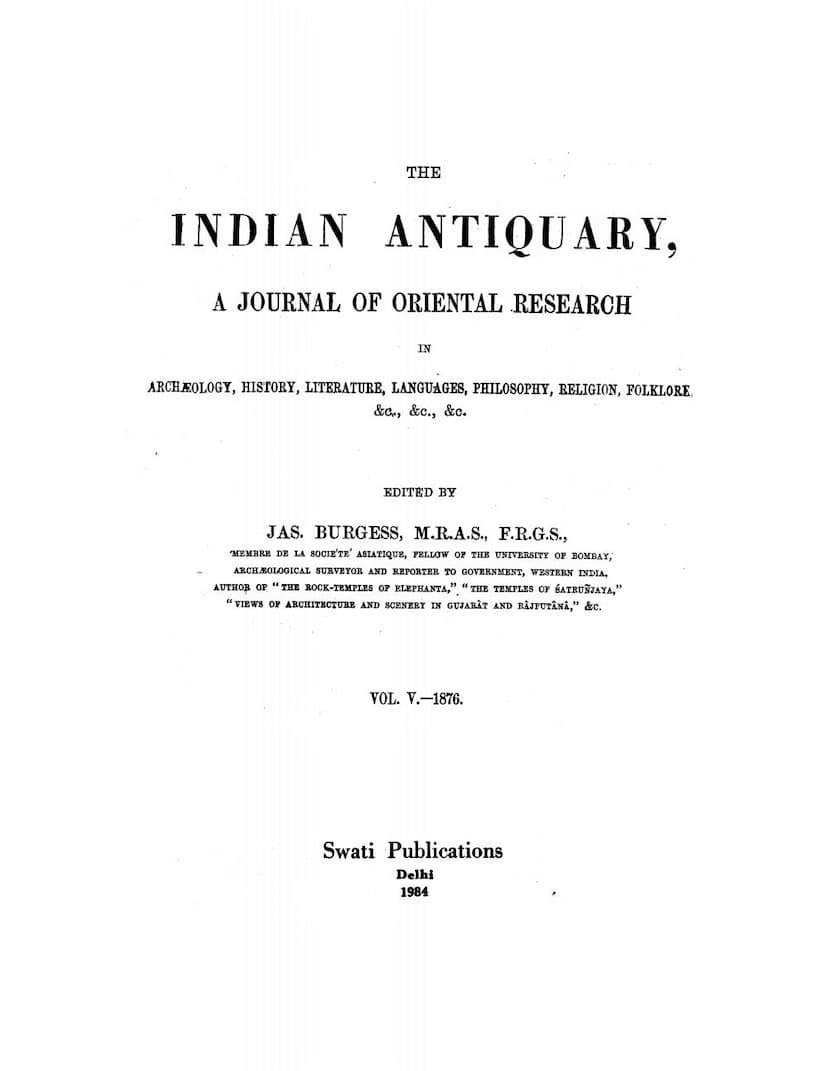Indian Antiquary Vol 05
Added to library: September 1, 2025

Summary
Here's a comprehensive summary of the provided Jain text from the Indian Antiquary, Vol. V, focusing on its relevant content related to Jainism, while also acknowledging the broader scope of the publication:
Overall Publication Context:
The Indian Antiquary, Vol. V (1876), edited by Jas. Burgess, is a journal of Oriental research covering a wide range of topics including archaeology, history, literature, languages, philosophy, religion, and folklore. The provided excerpt showcases a diverse collection of articles from various scholars, highlighting the journal's commitment to comprehensive Indian studies. While many articles delve into Hindu and Buddhist topics, as well as general history and linguistics, there are specific mentions and sections pertaining to Jainism.
Key Jain-Related Content:
The most direct and substantial content related to Jainism is found in the section titled ARCHÆOLOGICAL NOTES by M. J. WALHOUSE, LATE M.C.S.
-
No. XI. - A Jain Temple and Sásana: This section specifically describes a Jaina temple at Yênûr, a village noted for its surviving Jain population.
- Colossal Jain Statue: The text details a colossal Jain statue at Yênûr, which is monolithically carved and stands on an elevated terrace. It is described as being lower than the Karkala statue but still impressive. The statue is characterized by its broad square shoulders, thick and long arms, well-proportioned legs, and specific facial features, including a "deep grave smile." The inhabitants refer to it as "Gumtâ Raja or Gômateśvara."
- Jaina Pillars: The presence of "wonderful Jaina pillars" is noted, described as a type peculiar to South Kanara. These are monolithic shafts rising about thirty feet high, quadrangular at the base, with intricate interlacing stone-work, octagonal and sixteen-sided sections, and ornate capitals and canopies. The pillars bear relief sculptures of "long-armed, curly-headed Tirthankaras."
- Jaina Temples at Yênûr: The village itself contains "two or three Jaina temples." One temple, just outside the colossus enclosure, houses a life-sized brass image. Another temple contains a large black marble image.
- Twenty-four Tirthankaras: A small building adjacent to a temple contains "the twenty-four Tirthankaras, in a row, all of the same size," carved in black stone, each under a horseshoe-shaped arch.
- Architectural Doorway: A particularly remarkable feature described is a "doorway quite a wonder of exquisite and beautiful workmanship" set in a rough stone wall. This doorway is framed with black serpentine slabs, carved with intricate patterns of foliage, rosettes, and mouldings. The inner door-step features a lion's head and rosettes.
- Dating and Origin: While the exact date of the Yênûr colossus is unknown, the text speculates on its transport as a marvel of engineering. The statues at Karkala and Yênûr are traditionally attributed to "Jakkaṇāchâri," a figure akin to the Hindu Wayland Smith, known for his craftsmanship. The legend also mentions his descendants becoming Bhůtas or demons, with Jakkaṇāchâri himself being a feared demon named Kalkatti.
- Linguistic Interest: The description of the inhabitants and their customs, including their beliefs about dwarfs and the potential origin of the word "Fairy" from Tamil "Pey-devil," touches upon linguistic and folkloric aspects relevant to the region.
-
Other Mentions:
- Colossal Jaina Statue at Yênûr (Illustration): A plate is provided showing a "Colossal Jaina Statue at Yênûr," visually confirming the description in the text.
- Jaina Pillar at Yênûr (Illustration): Another plate illustrates a "Jaina Pillar at Yênûr," showcasing the intricate carvings.
- Door Frame of Black Marble at Yênûr (Illustration): A detailed illustration of the ornate doorway described in the text is also included.
- Fragment of inscription mentioning Jina: No. XIII, a Chalukya inscription from Aihole, mentions the erection of a "stone temple of Jinêndra," indicating the presence of Jainism in that region during the Chalukya period.
- Valabhi Grants (B and C): While primarily about the Valabhi dynasty, the commentary on the grants mentions that the "Great King Guhasena" (Pl. II, 1. 6) was "the ardent devotee of Buddha," suggesting a potential for religious syncretism or patronage of various faiths during that era, which might indirectly relate to the spread of Jainism or its interactions with other religions. However, the text clarifies in the commentary that Guhasena's devotion was to Buddha, not Jainism.
Other Sections of Interest (Indirectly or Generally Related):
- Sanskrit and Old Canarese Inscriptions: Several inscriptions from various dynasties (Kadamba, Chalukya, Vijayanagara, Kalachuri, Pallava) are transcribed and translated. While not directly Jain, they provide historical context for the periods and regions where Jainism flourished. The mention of Jain statues and temples in the context of these dynasties is significant.
- Notes on Villages in the Himalayas: This section touches upon religious practices and folk beliefs, which, while not explicitly Jain, offer a broader understanding of religious life in ancient India, a context within which Jainism also existed and evolved.
- Sanskrit MSS. from Kashmir: The discovery and collation of Sanskrit manuscripts mention various branches of Indian learning, including philosophy, where Jain philosophy might be studied in comparison.
Summary of Jain Content:
The primary focus on Jainism within this volume is the detailed description and illustration of the colossal Jaina statue and associated temples and pillars at Yênûr. This section highlights the artistic and architectural achievements related to Jainism in South Kanara. The mention of "Jina" in other inscriptions indirectly confirms the presence and importance of Jainism in different regions and periods of ancient India. The broader context of the Indian Antiquary shows how inscriptions and archaeological findings contribute to understanding the historical and cultural landscape in which Jainism thrived.